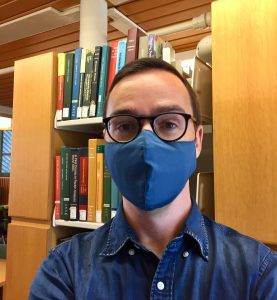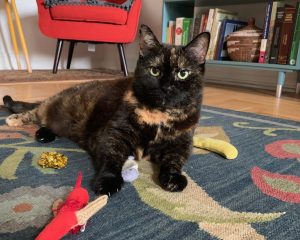Q: What was your transition from in-person work to remote work like? Describe your typical day while working from home.
It was a very abrupt transition! I had the chance to get some items from my office before remote work began, but I started working from home on March 16 and didn’t set foot on campus again until August 7. I’m now working on campus one day per week and working from home the rest of the time.
In my role I supervise four subject specialist librarians and plan research support and outreach activities for the Science, Engineering, & Social Science Libraries, as well as some initiatives in the Libraries more broadly. My typical day includes a lot of talking with people, whether that’s my direct colleagues or students, staff, and faculty. A usual day will consist of two or three meetings over Zoom; helping students and researchers through reference, workshops, or consultations; planning for events and projects; and plenty of email. This is all done from my “home office,” a.k.a. my couch. I’ve noticed that my work-from-home life is more balanced than when I’m working at my usual office, which is great. I spend less time getting to and from work and to different buildings around campus. (Getting lunch just involves walking to my kitchen and going from one meeting to another just means signing in to a Zoom call.) This allows me to take necessary breaks during the day.

Q: How have you managed to provide online instruction for students now that the Libraries’ consultations and workshops are entirely virtual? What challenges have you experienced and how have you overcome those?
We very quickly moved most of our in-person research support services, such as research consultations, workshops, and orientation sessions, to Zoom. There were a lot of logistics to figure out early on, but after getting accustomed to remote instruction and some trial and error figuring out which of Zoom’s features are (and aren’t) useful for teaching, we’ve found quite a few upsides. One of those is that we are able to reach many more students through our workshops than before. Typically, we were only able to accommodate up to 15 people per session due to space limitations, but having workshops online allows for people to drop by from wherever they may be and attend. We had as many as 60 people attend a single workshop last semester! There are some things that don’t translate easily to a Zoom session, such as hands-on activities and group discussions, and there are more technical issues that can come up than usual. Overall, though, we’ve realized the advantages of offering at least some of these traditionally in-person services at a distance even after we’re able to resume things face-to-face.
Q: How has virtual reference expanded since the service launched?
Our Ask A Librarian chat service is a good illustration and it has grown exponentially in several ways over a short period of time. To start, we increased our hours from 43 hours per week to 73 hours, which allows us to provide instant help to library users across a number of time zones. We added 14 additional people to our group of chat reference operators, which now includes more than 50 staff members who work in various roles and have expertise in a very wide range of subjects.
We receive so many questions during our busiest hours, 11am – 4pm EST, that we now have two staffers signed on during those hours to ensure library users will receive a quick reply. As one of the people who operates the Ask A Librarian chat, I can say that it has become more fast-paced and the questions are more difficult to answer due to the many changes to library services that COVID-19 has necessitated, but that’s part of the fun!
Q: How can students access virtual reference services? What sorts of questions/topics are staff able to address?
Our Ask a Librarian page is the best way to get in touch with a librarian. If you have a longer or more involved question about research or library tools, we recommend requesting a consultation, which is a one-on-one appointment that is scheduled with a librarian. Other than that, the Ask A Librarian chat is an excellent starting point for all types of questions related to the Libraries. The chat service is available 9am – 9pm EST, Monday – Thursday, and has slightly shorter hours Friday – Sunday. (The full listing of hours can be found at our Ask A Librarian chat service hours page.)
We answer all questions about using the Libraries and can help you find the information and resources you need, but there are certainly some questions that come up more often than others. Some that we receive frequently include:
- I’m having trouble accessing an article. Can you help me get it?
- I’m beginning my research, but I’m not sure where to start. Can you recommend somewhere to search for my topic, or refer me to a librarian who specializes in my subject?
- How can I get access to The New York Times or other newspapers’ content through the Libraries?
- I’m looking for books and articles on my topic, but nothing is coming up. Can you help?
- I need a tool to help me cite and manage my sources. Can you offer guidance on this?
That said, we enjoy getting all sorts of questions and will refer you to the right place if we can’t provide an answer, so don’t hesitate to get in touch!
Q: Do you have statistics related to the use of virtual reference over the course of the Fall term?

The increase in use of our virtual reference has been something to behold and shows just how important it is to have an easy point of contact for library users. In September 2020, for example, there were 1,415 chat sessions, compared to the 591 questions we received in September 2019 (a 139% increase). Over the semester, in Fall 2020 there were 4,279 chat sessions, compared to 1,942 for the same period in 2019 (a 120% increase). Looking at the numbers for the entire year, more than 9,000 chat sessions took place in 2020. That’s a lot of questions asked and answered and, we hope, a lot of information and knowledge shared.
Q: What are you most looking forward to in 2021 in your work in the Libraries?
The staff in the Libraries work hard to build and maintain our collections, to ensure access to the materials that people need to learn and to build new knowledge, and to teach how to effectively find information and evaluate it critically as part of larger systems. There is also a lot of behind-the-scenes work going on to make the Libraries a place that’s more equitable and reflective of everyone in the Columbia community and more responsive to the social issues that impact us all. For example, our Diversity & Inclusion Committee is addressing a number of issues, from changing problematic terms used in Libraries’ metadata to describe items in our collections, to improving opportunities for advancement and retention among staff. I’m looking forward to contributing to efforts such as these and continuing to put people and the social impact of library work at the forefront of our decisions.